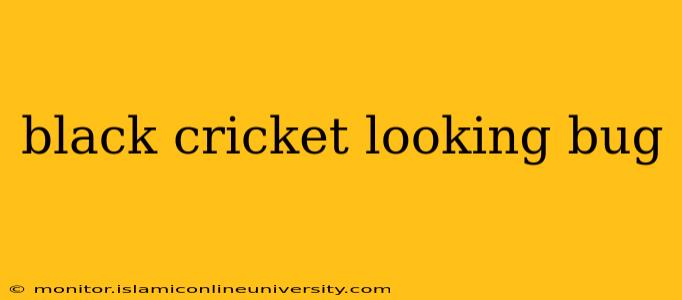Have you spotted a black insect that resembles a cricket but isn't quite right? You're not alone! Many insects share similar characteristics, making identification tricky. This guide will help you pinpoint the identity of your black cricket-looking bug, covering various possibilities and providing helpful distinguishing features.
What are some black insects that look like crickets?
Several insects could be mistaken for black crickets. The key is to look beyond just the general shape and color and examine details like size, antenna length, wing structure, and jumping ability. Some possibilities include:
-
Black Field Crickets: These are indeed crickets, often dark brown or black. They have long antennae, powerful hind legs for jumping, and typically have wings, although the extent of wing development varies depending on the species and sex.
-
Ground Beetles: Many ground beetles are black and have a somewhat elongated body similar to a cricket. However, they generally have shorter antennae than crickets and are often more robust in build. They are also usually better runners than jumpers.
-
Mole Crickets: While not always black, some mole cricket species are dark-colored. They have distinctive forelegs adapted for digging, making them easily distinguishable from true crickets.
-
Jerusalem Crickets (or Potato Bugs): These large, flightless insects are often mistaken for crickets due to their size and somewhat similar body shape. They are typically dark brown or black, and possess powerful mandibles (jaws).
-
Certain species of Cockroaches: While not all cockroaches are black, some species have a dark, almost black coloration and could be mistaken for a cricket from a distance. Their antennae are long and they tend to move more quickly.
How can I tell the difference between a cricket and a black beetle?
The most reliable way to distinguish between a cricket and a beetle lies in their anatomical differences.
-
Antennae: Crickets generally have long, thread-like antennae, often longer than their bodies. Beetles, on the other hand, tend to have shorter, clubbed, or segmented antennae.
-
Wings: Crickets typically have two pairs of wings – a leathery forewing and a membranous hindwing. Beetles possess a hardened forewing (elytra) that covers their hindwings.
-
Legs: Crickets have strong hind legs designed for jumping. While many beetles have powerful legs, their leg structure and usage may differ significantly.
-
Body Shape: Crickets tend to have a more streamlined, cylindrical body. Beetles are often more robust and have a broader body shape.
What kind of black insect has long antennae and jumps?
An insect with long antennae and jumping ability points towards a cricket species, potentially a black field cricket or a similar species. However, even within the cricket family, there's variation in size and color. A clear picture would be helpful for more precise identification.
What black insects are attracted to lights?
Many insects, including certain beetles and crickets, are attracted to artificial lights. This behavior, known as phototaxis, can be a useful observation in identifying the insect. However, it's not a definitive identifier on its own.
Are black cricket-looking bugs harmful?
Most black insects resembling crickets are not harmful to humans. However, some species, like certain ground beetles, may have a defensive bite if handled roughly. Mole crickets can be a nuisance to gardeners, damaging roots and plants. Always exercise caution when handling any unknown insect.
Where do black cricket-looking bugs live?
The habitat of your mystery insect provides crucial clues. Ground beetles are typically found in soil, under rocks, or in leaf litter. Crickets favor grassy areas, fields, and gardens. The location where you find the insect significantly narrows down the possibilities.
This guide provides a starting point for identifying your black cricket-looking bug. For a definitive answer, consider taking a clear photograph and consulting with an entomologist or using online insect identification resources. Remember to observe the insect's behavior, habitat, and physical characteristics for the most accurate identification.
